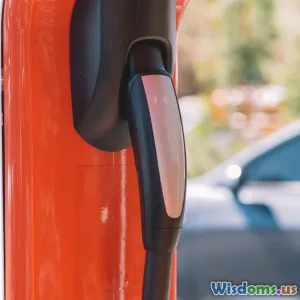
How to Boost Your Cars Fuel Efficiency with Smart Driving Apps
8 min read Discover how smart driving apps can boost your car's fuel efficiency and save money while reducing emissions. (0 Reviews)
How to Boost Your Car's Fuel Efficiency with Smart Driving Apps
Fuel efficiency is more than just a feature; it’s a necessity in today's world where rising fuel prices and environmental concerns dominate the landscape. Imagine if your smartphone could help you save fuel miles after mile—without extra equipment or expensive gadgets. That’s the promise of smart driving apps. These innovative tools empower drivers to refine their driving habits, reduce fuel consumption, and contribute positively to the environment. In this article, we’ll take a deep dive into how these apps work, their benefits, and actionable tips on maximizing your fuel efficiency using technology.
Understanding the Importance of Fuel Efficiency
Fuel efficiency isn't only about saving money—it's about optimizing how your vehicle operates and minimizing environmental impact. In the US alone, passenger vehicles consume nearly 120 billion gallons of gasoline annually. Even a 10% improvement in fuel efficiency can save billions of gallons, significantly cutting emissions and expenditure.
While automakers strive to produce more efficient vehicles, drivers themselves have a pivotal role. Studies reveal that driving style contributes up to 33% of fuel economy variability (DOE, 2021). This means your behavior behind the wheel can have a marked effect on how much fuel you burn.
What Are Smart Driving Apps?
Smart driving apps are mobile applications designed to monitor your driving habits, provide feedback, and suggest improvements for fuel economy. Unlike traditional navigation apps, these focus on behavioral insights rather than just directions.
Many connect to your car’s onboard diagnostics via Bluetooth (OBD-II adapters) to gather detailed data on acceleration, braking, speed, and idling times. Others use the phone’s GPS and accelerometer sensors to assess dynamics. The fusion of real-time data and AI-driven analytics enables precise coaching tailored to each driver.
Core Features of Fuel Efficiency Apps
- Driving Behavior Analysis: Tracks aggressive acceleration, harsh braking, and idling.
- Fuel Consumption Estimation: Calculates estimated miles per gallon (MPG) based on driving patterns.
- Trip History & Trend Insights: Enables long-term improvement with detailed driving reports.
- Eco-friendly Route Suggestions: Identifies routes that reduce stop-and-go traffic or unnecessary distance.
- Maintenance Alerts: Reminds users about vehicle service which affects efficiency (e.g., tire pressure, oil changes).
Benefits of Using Smart Driving Apps
Enhanced Fuel Economy and Financial Savings
For example, according to a trial conducted by a UK-based taxi firm using such apps, drivers improved fuel efficiency by up to 15%. Given the average US driver spends over $2,000 annually on fuel (AAA, 2023), this could translate to hundreds in savings each year.
Environmental Impact Reduction
By lowering fuel consumption, these apps help reduce carbon dioxide emissions. The EPA estimates that cars emit about 4.6 metric tons of CO2 per year on average. Even modest fuel savings compound into meaningful ecological benefits.
Safer Driving Practices
Since many apps discourage speeding and aggressive maneuvers, they inadvertently promote safer roads.
Popular Smart Driving Apps to Consider
1. Fuelly
Fuelly isn’t just a tracking app—it lets users record fuel-ups, miles driven, and monitor vehicle performance over time. The community-based nature provides comparisons across similar car models for realistic benchmarks.
2. EcoDrive
EcoDrive uses gamification and coaching to engage drivers. It measures harsh braking, rapid acceleration, and idle time, offering real-time tips. Drivers can compete with friends, creating a social incentive for eco-driving.
3. Drivvo
Drivvo combines expense tracking and vehicle maintenance with fuel efficiency data. It allows you to view trends and estimate cost savings achieved through better driving.
4. GotchaFuel
This app automatically records fuel data via scanning receipts or inputting details and integrates with OBD adapters. It’s favored for its simple, no-fuss UI.
Practical Tips to Maximize Fuel Efficiency Using Apps
Combine App Insights with Smart Driving Habits
Apps provide data, but it's up to you to act on it:
- Smooth Acceleration and Deceleration: Avoid rapid starts and stops flagged by apps.
- Steady Speeds: Use cruise control where possible, especially on highways.
- Reduce Idling: Many apps monitor idling times and encourage turning off engines during extended stops.
Monitor Vehicle Health
Regular maintenance is just as important as driving style. Apps often send reminders for tire checks and oil changes—simple actions that further improve mileage.
Plan Routes Using App Recommendations
Some apps suggest routes that minimize traffic congestion. Fewer stops and starts mean better fuel economy. For instance, mapping features can reroute to avoid heavy traffic zones or roadworks.
Set Realistic and Incremental Goals
Use app metrics to set weekly or monthly fuel efficiency targets. Small consistent improvements add up over time. For example, reducing harsh braking incidents by 20% in a month can increase efficiency by several MPG.
Real-World Insight: A Case Study
A 2022 study by the University of Michigan tested EcoDrive on a fleet of delivery vehicles. Over three months, drivers reduced fuel consumption by 12.5%. The behavioral feedback, combined with coaching alerts, was credited with lasting positive driving behavior changes. Drivers also reported safer driving and less vehicle wear and tear.
Conclusion: Driving Efficiency into the Future
The integration of smart technology into our vehicles is revolutionizing the way we drive—not just faster or safer, but smarter and greener. Smart driving apps serve as indispensable allies for today’s eco-conscious driver looking not only to save money at the pump but also to do their part against climate change.
Taking advantage of these apps brings transparency to your driving habits and actionable insights for improvement. Combined with good old-fashioned discipline, they can transform your car from a gas-guzzler into a fuel saver.
So, whether you commute every day or hit the open road on weekends, it’s time to make your smartphone your fuel-efficiency coach. Embrace technology, embrace savings, and embrace eco-conscious driving.
Drive smart, save fuel, and contribute to a cleaner planet—one mile at a time.
Rate the Post
User Reviews
Popular Posts



















